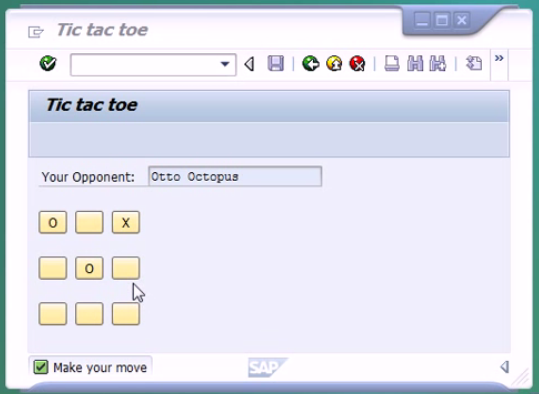Warning: This blog post is going to be techy, but also fun. I will show how I realized an idea that has been in my head for quite some time: creating a multiplayer game in ABAP. Who wouldn’t want to play games with his/her colleagues while your boss thinks you’re very busy working in SAP?
Fighting problems of asynchronous processing in ABAP
In most Standard SAP applications, changes to data are not directly (“synchronously”) written back to the database. Instead, SAP Netweaver buffers these changes and writes them at a later time (“asynchronously”).
On many occasions, you won’t notice this asynchronous nature and it won’t cause any problems. Even better, asynchronous processing is good for performance! However, sometimes you’ll want to continue processing only when the database is completely up-to-date. For example:
- When you are trying to get additional data not returned by the BAPI or Function Module you just called;
- When you want to run another BAPI or Function Module that depends on the database being completely up to date after the previous call.
Especially in interface programming, I have seen some cumbersome solutions. The good news is: There are good solutions to enforce synchronous processing. This post lists these options. Continue reading
The future of Java Web Dynpro. How will it affect Netweaver BPM?
During the SAP Teched 2010, SAP has caused some commotion when it gave Java Web Dynpro the so called ‘kiss of death’. Basically, active development on the Java Web Dynpro technology will be stopped and the next edition of NetWeaver will be the last major enhancement for Web Dynpro Java. The implicit message from SAP seems to be: the future of Web Dynpro lies in ABAP.
Since a few years, SAP maintains two branches of UI technology, built on totally different technical foundations: ABAP Web Dynpro and Java Web Dynpro. This situation exists for historical reasons, but for me it always made little sense to build and support the same technology twice in different stacks.
Impact on Netweaver BPM
Now that the dust has settled a bit, what does the ‘death’ of Java Web Dynpro mean for Netweaver BPM technology which is just starting to mature?
CORA in practice: developing a ROA based iPhone App connecting with SAP: Part II
Authors: Wilco Menge, Maarten Engels
Note: This blog post has been previously published on coramodel.com and on the front page of sdn.sap.com.
Introduction
This blog post is the second in a serie of two describing the findings and lessons learned of applying the CORA model in a software development project. This project is based on a demo scenario, and CORA is used as a tool to support architecting software.
In the first blog post the demo scenario and it’s background were described. Also, the actual mapping of components in the demo scenario onto the CORA model were shown. In this blog post we present the findings and lessons learned from this project. Also CORA’s benefits and our next steps in the project are outlined.We start with the mapping on the CORA model. Continue reading
CORA in practice: developing a ROA based iPhone App connecting with SAP: Part I
Authors: Wilco Menge, Maarten Engels
Note: This blog post has been previously published on coramodel.com and on the front page of sdn.sap.com.
Introduction
This blog post is the first in a serie of two describing the findings and lessons learned of applying the CORA model in a software development project. This project is based on a demo scenario where CORA is used as a model to support architecting software.
In this blog post the post the demo scenario and it’s background is described. Also, the actual mapping of components in the demo scenario onto the CORA model is shown. In the second blog post we present the findings and lessons learned from this project. Also CORA’s benefits and our next steps in the project are outlined.
Background
During the last two years or so, Resource Oriented Architecture (ROA for short [1]) has become more and more common as an alternative for other application styles such as n-tier and SOA. In particular, the rise of so called “Web 2.0” applications on the Internet contributed greatly to the popularity of ROA as an implementation of the REST architecture, in particular due to it’s simplicity and it’s light-weight.
We became curious: what would ROA do in an SAP environment? Could ROA be an alternative for SOA? We already knew others were working on communicating with SAP through REST, but we wanted to take it one step further: we wanted to see whether we could make ROA work in a real life application that could really provide value to users! Continue reading

